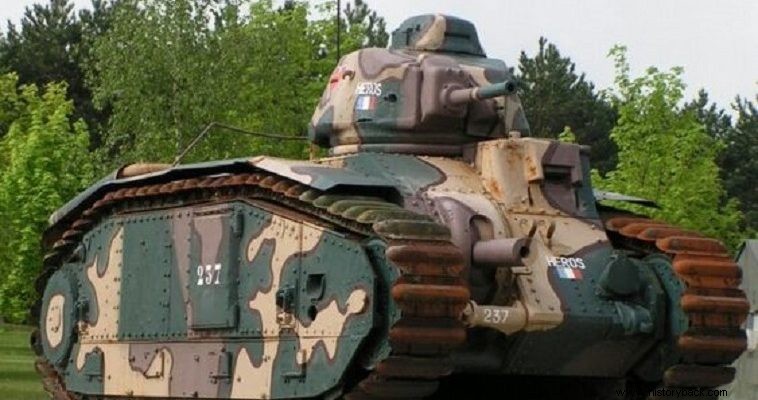
The French Army of 1940 had four types of fast moving divisions, Light Cavalry Divisions, Light Armored Divisions, Mixed Armored Divisions and Motorized Infantry Divisions. The motorized infantry divisions had the same composition as the regular infantry divisions. But they had motorized means of transport.
The Light Cavalry Divisions were the evolution of the old cavalry divisions. They were formed in 1936, modeled on the "Celere" divisions of the Italian Army. Each of the five that existed consisted of 4 cavalry regiments, a battalion of infantry dragoons, artillery and services. Each cavalry regiment had 5 regiments, 4 mounted cavalrymen and one regiment of armored reconnaissance vehicles - or light tanks.
In total each division had 64 armored vehicles. These divisions would, in theory, undertake reconnaissance, slow down and contact missions. But their equipment did not really allow them to carry out such missions, even against common infantry divisions, which were superior to them in numbers of guns and men.
In 1937 it was decided to form the light armored divisions. These were the first real armored divisions of the French Army. They had about 150 tanks each of the Somua S-35 and Hotchkiss H-35 or H-39 or Renault AMC or R 35 types.
The Somua tanks were probably the best the French Army had. It had sloping armor of a maximum thickness of 56 mm. and they were armed with the best anti-tank gun of the time, the 47 mm. which was capable of penetrating the armor of all German tanks of the time.
In contrast the Hotchkiss tanks, although well armoured, were mostly armed with the ridiculous 37mm/21 caliber SA gun. The H-39 prototype was armed with a 37mm/33 caliber gun.
The Renault R 35 tank was well armoured, but was slow and armed with a 37 mm short-barreled gun. In contrast, the Renault AMC was armed with either a 47 mm cannon. or with a 25 mm cannon, initial velocity of 900 meters/second. But it was behind in armor.
Only at the end of 1938 did the French staff decide on the formation of real armored divisions, mixed, as they were called, because they also had organic motorized infantry divisions. By the time the German offensive began three such divisions had been formed and a fourth was being formed. Each armored division had 60 B1 heavy tanks and 120 H-39 light tanks.
The B1 tanks had strong armor with a maximum thickness of 60 mm. and were armed with a 47mm anti-tank gun. in the tower and with a 75mm gun. in a special canopy, in the front right part of the boat. Its only drawback was its slow speed.
However, his excellent armor ensured his great survivability. The armor of the B1 was able to withstand even the blows of the short-barreled 75 mm cannon. with which the heaviest German tanks of the time, the Pz IV.
, were equippedOnly the famous 88mm cannon was capable of destroying it. As of May 10, there were 384 tanks of the type in service. However, as the historian E. Bayer rightly puts it in his book "The Armored War", an armored division "...is not only 500 tanks, but is above all a doctrine of use and a staff highly trained in its work, capable of handling 3,000 vehicles, moving them, using them on the battlefield, and finally refueling and repairing them normally".
On this very point the French were lagging behind. The myth, which they themselves cultivated about the superiority of German tanks, was created only to justify their disastrous and shameful defeat. So the 1st French Armored was destroyed because its tanks ran out of fuel, while the 3rd because the commander threw their divisions into battle gradually, one after the other and not concentrated.
In the only instance where an armored division was used in an orthodox manner, de Gaulle's 4th succeeded in its mission, regardless of whether it was eventually forced to retreat under Stuka bombs.
The only occasion where a large-scale tank battle took place was on 12 and 13 May between Ani and Varem, where the Somua and H-35s of the French 2nd and 3rd Light Armored Divisions confronted the 3rd and 4th Panzers. And yes, the French were defeated and forced to retreat, but they taught the Germans a very hard and bloody lesson.
The problem was therefore the inability of the French generals to distinguish the usefulness of the chariot as a means of deciding the struggle. On the contrary, the French campaign manual explicitly stated that tanks were simply vehicles to accompany the infantry, whose energy they assisted, but did not replace.
According to the rules of battle, the tank was simply the servant of the infantry, and the seven French armored divisions in total were destroyed in small "packages", one after the other, without offering the least.
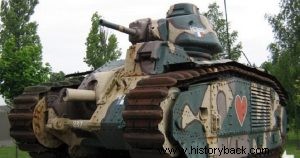
French tank B 1 Bis. These tanks were superior to anything the Germans had fielded. It had a 75 mm gun. on board and 47 mm. in the tower. Its only drawback was its slow speed.

French H 35 light tanks armed with a 37 mm short-barreled gun.

The Somua S 35 tank was the best medium tank in the world at the time. It was equipped with a 47 mm gun. and could face all German tanks.
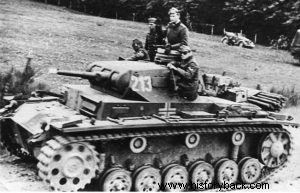
German Pz III tanks. with a 37mm gun.

German Pz IV tank equipped with a short-barreled 75 mm gun. The tank in question was the heaviest in service in 1940 and could be countered by the French Somus S 35 and B 1 bis.
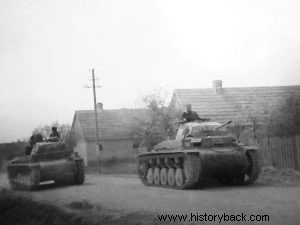
German Pz II tanks. They brought a 20mm cannon. as their main armament and their armor was light.

German tank Pz I. It was armed with only two machine guns.

The Germans used significant numbers of Czechoslovakian origin Pz 35 t and Pz 38 t tanks in France as well. Both carried a 37 mm cannon. and light armor. The photo shows a Pz 35 t.
tank
Tank Pz 38 t of the German army.

Abandoned French Hotchkiss H39 light tank. It carries a 37mm cannon.

French Renault R 35 light tanks. They carry a short 37 mm gun.
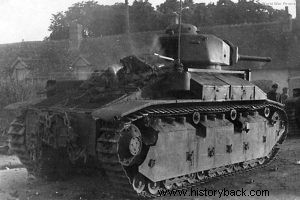
1938 Model D2 French Medium Tank with 47mm Gun Turret

French "heavy" tank C2. Only 10 of these were built. Only their weight (69 t.) justified the designation heavy. It had less armor than the Somua S 35. It carried a 75 mm gun. and four machine guns.
